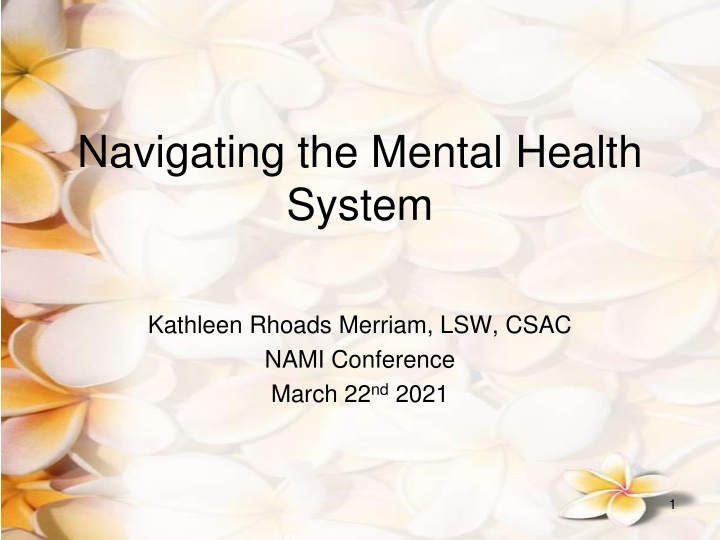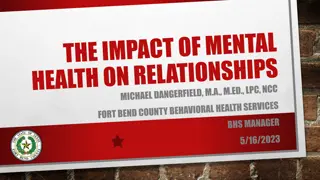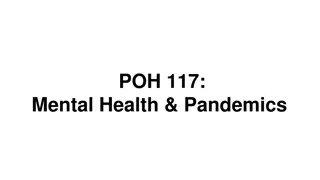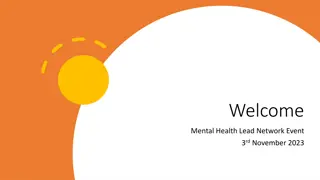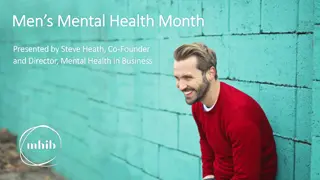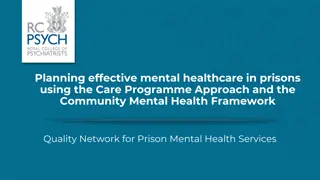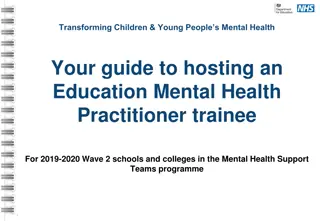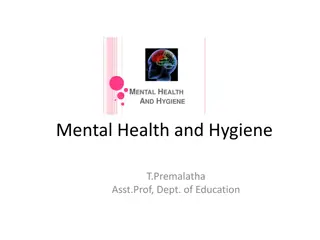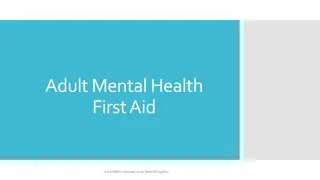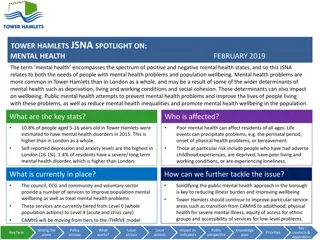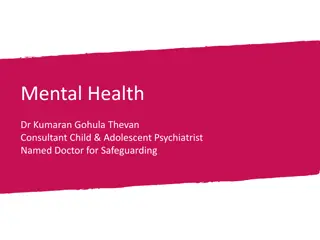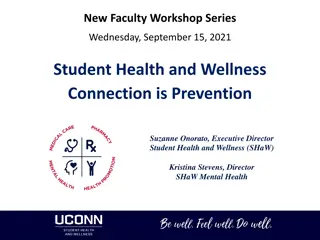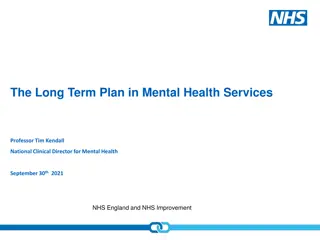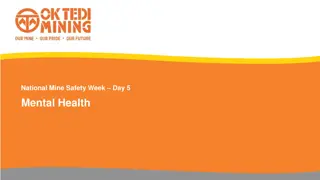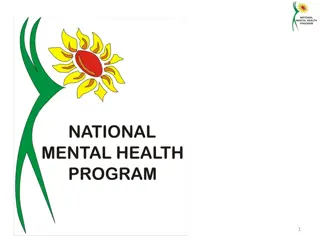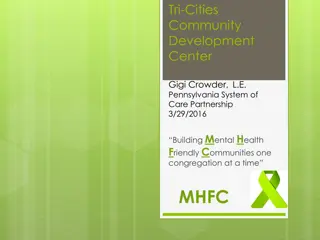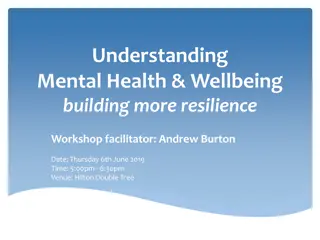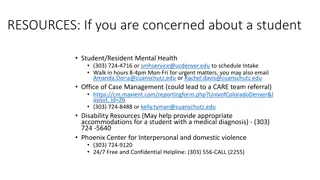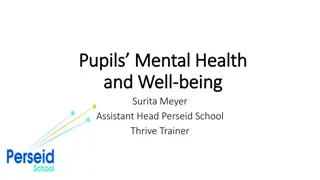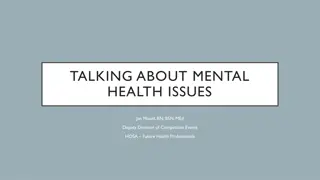Navigating the Mental Health System for Better Support
Importance of mental health, factors affecting it, and the significance of seeking help. Highlighting the stigma faced by families and the roles they play in providing care and support.
Download Presentation

Please find below an Image/Link to download the presentation.
The content on the website is provided AS IS for your information and personal use only. It may not be sold, licensed, or shared on other websites without obtaining consent from the author.If you encounter any issues during the download, it is possible that the publisher has removed the file from their server.
You are allowed to download the files provided on this website for personal or commercial use, subject to the condition that they are used lawfully. All files are the property of their respective owners.
The content on the website is provided AS IS for your information and personal use only. It may not be sold, licensed, or shared on other websites without obtaining consent from the author.
E N D
Presentation Transcript
Navigating the Mental Health System Kathleen Rhoads Merriam, LSW, CSAC NAMI Conference March 22nd2021 1
Why does it matter? Mental health can change over time depending on many factors. When demands placed on a person exceed their resources and coping abilities, their mental health can be impacted; for example, stressful situations like divorce, working or studying long hours, caring for an ill relative or experiencing economic hardship can lead to poor mental health. Major example? COVID-!9 There is no single cause for mental illness. Several factors can contribute to risk for mental illness such as: Early adverse life experiences including experiencing or witnessing trauma or a history of abuse (child abuse or sexual assault) Experiences related to other chronic medical conditions such as cancer or diabetes Biological factors-genetics or chemical imbalances in the brain Use of alcohol or recreational drugs Having few friends Feeling lonely or socially isolated Hawaii Health Data Warehouse, 2020
Why care? Mental Health Matters! There are more than 200 classified types of mental illness. Mental illnesses are among the most common health conditions in the United States. According to the Centers for Disease Control and Prevention (CDC): More than 50% of Americans will be diagnosed with a mental illness or disorder at some point in their lifetime. 1 in 5 adults (over 43 million Americans) will experience a mental illness each year. 1/2 of all incarcerated people have MH problems; 60 percent have substance use problems; 1/3 have both (SAMHA, 2018) 1 in 25 American adults (9.8 million people) live with a serious mental illness, such as schizophrenia, bipolar disorder, or major depression. Add a substance? Treating at same time? Integrated Care: statistics vary greatly. Hawaii Health Data Warehouse, CDC, NAMI, 2020
The stigma of being a family member The various labels and stereotypes Meddler Intrusive Hovering Annoying Nosey 7
Get off the Merry-go-round! Stop going in circles! Connecting Linking - Syncing 8
The many hats we wear Advocate: Does my loved one have questions and/or concern? Are we concerned about the quality of care? Educator: How and when do I share my rich and extensive about of knowledge? Mentor: Who is open to and accepting of me, my role, and my influence Provider: Everything from shelter to medication monitoring. Transportation to crisis intervention. Socialization to managing finances 9
C ultural humility & cultural integrity can you help the P rovider? How do different cultures deal with crises? Are our services culturally grounded, attuned, sensitive, congruent, and competent, as well as personalized to meet everyone's unique needs? C ultural humility & cultural integrity can you help the P rovider? 10
Learn about Trauma Informed Care (TIC) and advocate for it! Services and supports need to be trauma-informed to foster safety (physical and emotional) and trust, as well as promote choice, empowerment, and collaboration. 5 Core Values of Trauma-Informed Care (Fallot, 2016) 1. Safety: creating a physically and emotionally safe environment 2. Trustworthiness: working on building trusting relationships 3. Choice: offering involvement in decision making 4. Collaboration: working as partners with each other 5. Empowerment: building skills and confidence for optimal growth These values are essential to building a trauma-Informed culture 11
Communication Tips Being a member of the treatment team Signed consent: When, how, why? Documentation: Keep a notebook of the who, when, what Empathy and understanding for the Provider, i.e., conditions for a CM 12
Knowing the main lingo CMO: Crisis Mobile Outreach MH-1to MH-6 LCRS: Licensed Crisis Residential TSS: Treatment Service Section, formerly known as CMHC SOSRP: State Operated Supervised Residential Program CBCM: Community Based Case Management RPR: Recovery Plan Review TQIC: Temporary Quarantine & Isolation Centers Crisis Stabilization Beds 13
Basis for EX-PARTE DANGEROUS TO OTHERS (HRS 334-1)- means likely to do substantial physical or emotional injury on another, as evidenced by a recent act, attempt or threat. "Imminently dangerous to self or others" means that, without intervention, the person will likely become dangerous to self or dangerous to others within the next forty-five days.
Concepts to understand State Operated Services Purchase of Services (POS) Utilization Management Treatment plan and Treatment meetings Community Mental Health Centers (TSS) Community Based Case Management Consents, information exchange Inpatient & Outpatient Services Supported Housing Level of Care (LOC) 15
COVID-19 Exposes Weaknesses How quickly can we mobilize communication? o Group Texts, checking email, faxes, etc. Quick adaptation, flexibility? Learning new things while stressed Information overload: Clarify best sources and limit others! Self care is not #1 skill Lack of experience with crisis management Computer knowledge? Zoom? Teams? 15
COVID-19 Highlights Strengths Individual Resiliency Moments of gratitude Clarifying/organizing processes Virtual options: i.e. AA/NA online, Facebook live, webinar trainings Focus on cleanliness Community-wide support and partnerships More efficient communication 16
Self-Managed Care My spiritual connectedness My medications Ohana My sleep My food/water My exercise/relaxation Managing my care providers Meaningful daily activities Leisure/social networks My vocation 18
The relationship with my doctor The relationship with my medication 19
The Value of Peer Support My 1st revelations in 1984: the power of PS Current examples of PS Specialists -Internships -Homelessness -Case management teams Hawaii Certified Peer Specialist (HCPS) Program Shared/Lived Experience 20
Websites for your Computer Favorites Toolbar Behavioral Health & Homelessness Statewide Unified Response Group www.BHhsurg.Hawaii.org Mental Health America Mentalhealthhawaii.org/808.521.1846 National Alliance on Mental Health (NAMI) 800.950.6264 NAMI.org/NAMIhawaii.org/808.591.1297 National Mental Health Consumer s Self-Help Clearinghouse Mhselfhelp.org/800.553.4539 American Foundation for Suicide Prevention AFSP.org David Mee-Lees online Tips & Topics (TNT)/www.changecompanies.com. Sign up for emails. Substance Abuse and Mental Health Services Administration SAMHSA.gov 25
